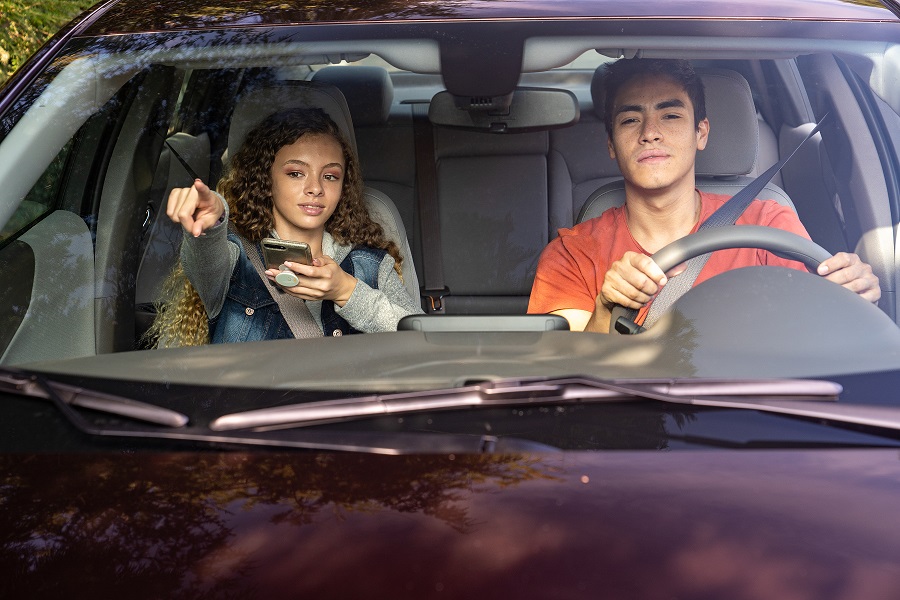2020 National Teen Driver Safety Week
 Parents and guardians, the greatest dangers for teen drivers — and the areas of focus for your conversation — are alcohol consumption, inconsistent or no seat belt use, distracted driving, speeding, and driving with passengers in the vehicle.
Parents and guardians, the greatest dangers for teen drivers — and the areas of focus for your conversation — are alcohol consumption, inconsistent or no seat belt use, distracted driving, speeding, and driving with passengers in the vehicle.
Be Empowered!
- Remind your teen driver that driving is a privilege, not a right. If they aren’t following the rules of the road, they don’t get to have the keys to the car.
- Whether you own the vehicle, or your teen owns the vehicle, they are living under your roof, and they need to follow the rules. This also means that, whether they want to or not, they need to listen to what you have to say about driving safety.
- Talk to your teen driver about driving laws. If they can’t follow the law, they can’t drive the car. You could save their life.
- Talking to your child about the importance of safe driving habits may feel tiresome for both parent and teen at times, but keep working at it. They are listening and they depend on you to set and enforce the rules.
- Become familiar with your state’s nighttime driving restrictions, passenger restrictions, and all the graduated driver licensing (GDL) restrictions, and help law enforcement and educators enforce them.
- Practice constant communication about safe driving skills. Self-reported surveys show that teens with parents who set and enforce firm rules for driving typically engage in less risky driving behaviors and are involved in fewer crashes. Don’t look at the conversation as nagging or bothersome — your teen is counting on you to not only set a good example, but to enforce the rules.
- Be a good role model for your teen driver and set an example with your own safe driving habits.
- Talk to your teen about safe cell phone use while in the car. Encourage them to stow their phones while driving, designate a texter, or to pull over before answering phone calls or responding to text messages.
-
Know the Facts about Teen Driver Fatalities
- Motor vehicle crashes are a leading cause of death for teens (15-18 years old) in the United States.
- In 2018, there were 2,121 people killed in crashes involving a teen passenger vehicle driver (15-18 years old), of which 719 deaths were the teen driver — a 5% decrease from 2017.
- Parents: You can be the biggest influence on your teen’s choices behind the wheel. Take the time to talk with them about some of the biggest driving risks for teens, including:
- Impaired Driving: All teens are too young to legally buy, possess, or consume alcohol. However, nationally, in 2018, 16% of teen drivers involved in fatal crashes had alcohol in their system. But alcohol isn’t the only substance that can keep your teen from driving safely: Like other drugs, marijuana affects a driver’s ability to react to their surroundings. Driving is a complex task, and marijuana slows reaction time, affecting a driver’s ability to drive safely. Remind your teen that driving under the influence of any impairing substance — including illicit or prescription drugs, or over-the-counter medication — could have deadly consequences. It is critical that teen drivers understand why they shouldn’t drive impaired, that they will face strict penalties and may lose their license if they are caught driving impaired, and that they will face additional consequences for breaking the rules they agreed to follow when they started driving.
 Seat Belts: Wearing a seat belt is one of the simplest ways for teens to stay safe in a vehicle. Yet too many teens aren’t buckling up. In 2018, almost half (45%) of the teen passenger vehicle drivers who died were unbuckled. Even more troubling, when the teen driver involved in the fatal crash was unbuckled, nine out of 10 of the passengers who died were also unbuckled.
Seat Belts: Wearing a seat belt is one of the simplest ways for teens to stay safe in a vehicle. Yet too many teens aren’t buckling up. In 2018, almost half (45%) of the teen passenger vehicle drivers who died were unbuckled. Even more troubling, when the teen driver involved in the fatal crash was unbuckled, nine out of 10 of the passengers who died were also unbuckled.
- Distracted Driving: Distractions while driving are more than just risky — they can be deadly. In 2018, among teen drivers involved in fatal crashes, almost 10% were reported as distracted at the time of the crash.
- Speeding: In 2018, more than one-quarter (28%) of all teen drivers of passenger vehicles involved in fatal crashes were speeding at the time of the crash, and males were more likely to be involved in fatal crashes than females.
- Passengers: Teen drivers transporting passengers can lead to disastrous consequences. Research shows that the risk of a fatal crash goes up dramatically in direct relation to the number of passengers in a car. The likelihood of teen drivers engaging in risky behavior triples when traveling with multiple passengers.
Remember the Rules of the Road
- Don’t Drive Impaired.
Set a good example by not driving after drinking or consuming marijuana or other impairing substances. Remind your teen that drinking before the age of 21 is illegal, and alcohol and/or marijuana and driving should never mix, no matter your age. Also remind them that driving under the influence of any impairing substance — including illicit, prescription, or over-the-counter drugs — could have deadly consequences.
- Buckle Up — Every Trip. Every Time. Everyone — Front Seat and Back.
Lead by example. If you wear your seat belt every time you’re in the car, your teen is more likely to follow suit. Remind your teen that it’s important to buckle up on every trip, every time, no matter what (both in the front and back seats), including in taxis and when using ride-sharing services.
- Eyes on the Road, Hands on the Wheel. All the Time.
Remind your teen about the dangers of texting, dialing, or using mobile apps while driving. Require your young driver to put their phones away when they are on the road and turn on the “Do Not Disturb” or similar feature on their phone. Distracted driving isn’t limited to phone use; other passengers, audio and climate controls in the vehicle, and eating or drinking while driving are all sources of dangerous distractions for teen drivers. Know your state’s law regarding mobile phone and texting while driving restrictions; 38 states and Washington, DC ban all cell phone use by novice drivers. See Distracted Driving Law Chart. If your teen disobeys, enforce the penalties you set for your teen before they started driving.
- Obey All Posted Speed Limits.
Speeding is a critical issue for all drivers, especially for teens who lack the experience to react to changing circumstances around their cars. Obey the speed limit, and require your teen to do the same.
- Limit Passengers.
With each passenger in the vehicle, your teen’s risk of a fatal crash increases. Review your state’s GDL law before your teen takes to the road; it may restrict the number of passengers in the vehicle during the initial novice driver permitting stage, and it may further dictate who can ride in a car being driven by a teen or novice driver.
Engage in Safe Driving Conversations Year-Round
Start the conversation with your teen about safe driving habits during National Teen Driver Safety Week, but continue the conversation every day throughout the year. Even if it seems like they’re tuning you out, keep reinforcing these rules. They’re listening — your constant reminders about these powerful messages will get through.
Get creative! Talking is just one way to discuss safe driving. You can also write your teen a letter, send email or text reminders, leave sticky note reminders in the car, or use social media to get your message across.
Get it in writing. Create a parent-teen driving contract that outlines the rules and consequences for your teen driver. Hang the signed contract in a visible place as a constant reminder about the rules of the road.
If you and your teen are going somewhere together, let your teen drive. Make sure he or she is following the rules you’ve set.
Finally, be empowered. Driving — for everyone, teen and adult alike — is a privilege, not a right. If your teen is having a difficult time following the rules, it may be time to take away the keys and review the basics. Safe teen drivers can mean the difference between life and death — for themselves, their passengers, and other people on the road.
For more information about National Teen Driver Safety Week and to learn more safe driving tips for your teens, please visit www.nhtsa.gov/road-safety/teen-driving
-
The information above was written by the U.S. Department of Transportation | National Highway Traffic Safety Administration.

